See some very early Jaime Hernandez in this multi-story filled fanzine, Fandom Circus!

Fandom Circus 2: 1978
Editor and publisher: Rich Lisiura
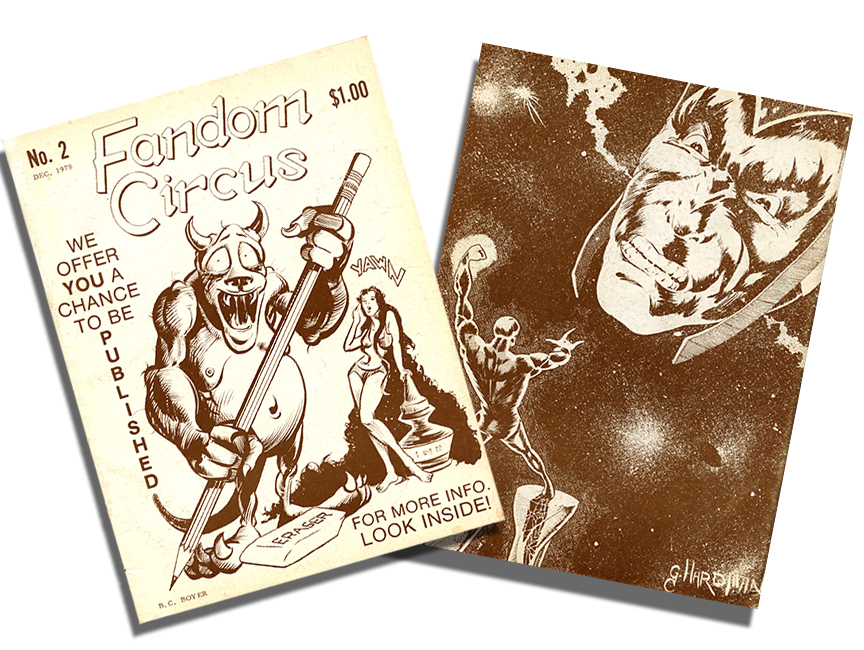
There were not many fanzines in the late seventies that were composed entirely or almost entirely of fully formed sequential stories. Most had a combination of illustrations and articles, with the odd comic story. Fandom Circus aimed to provide a forum for those creators that wanted to do just that…tell a story in comic format. The first issue, which I will profile at a later date, was printed in full size tabloid form (which will make it a pain to scan!), and had many members of the fan organization, InterFan, which I profiled back in an installment you can read here. This second issue is composed primarily of unknowns, many of which did not go on to careers in comics, or at least I have no knowledge of that. There is one big notable exception, but we will get to that in a bit.
Why not start at the cover, which you see above, along with the back cover. That front cover was done by one B. C. Boyer, whose work I have seen in other zines in the past. He had even then a confident, cartoony, and warm style. Unlike many young artists, he excelled at drawing children, as you will see in a few of the sampled pages below. In addition to the cover, he actually did two stories. Be sure to check out the pdf to read the stories as a whole.
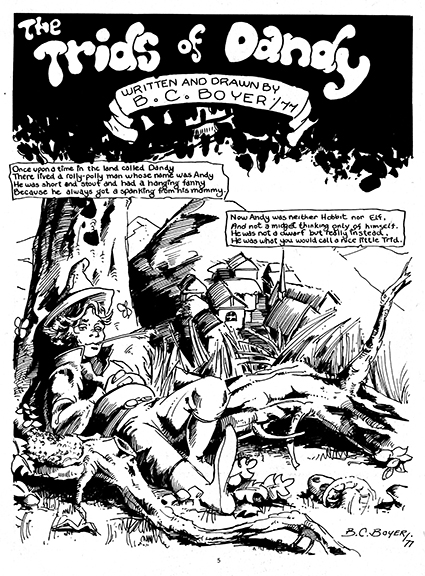
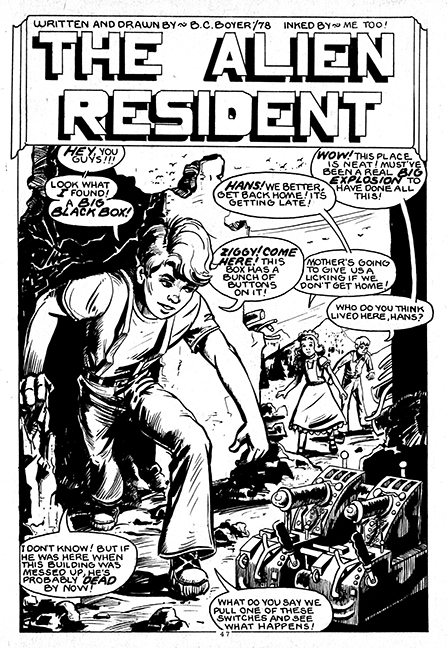
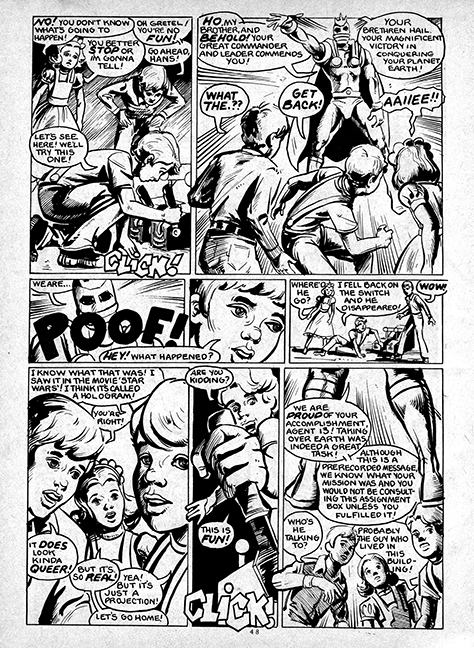
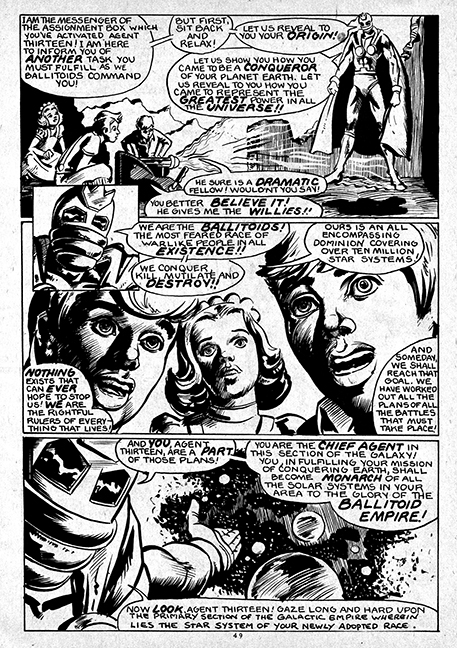

After the first Boyer story is the highlight (as far as comic history goes), a very early Jaime Hernandez story. This was a few years before his appearance in No Sex, another great fanzine from the past. I don’t know if he originally intended this to be a comic strip, rather than a comic book story, but the format might make someone reach that conclusion. As you can see below, it has a very rigidly formatted visual structure, but you can see little touches here and there of what would be seen in Hernandez’ work later in Love and Rockets. A funny aside…in the contents, he is actually listed as Jim Hernandez (and you can see below he calls himself James). Below is the whole story.
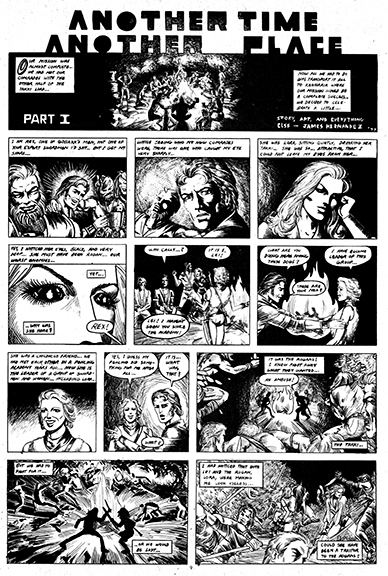
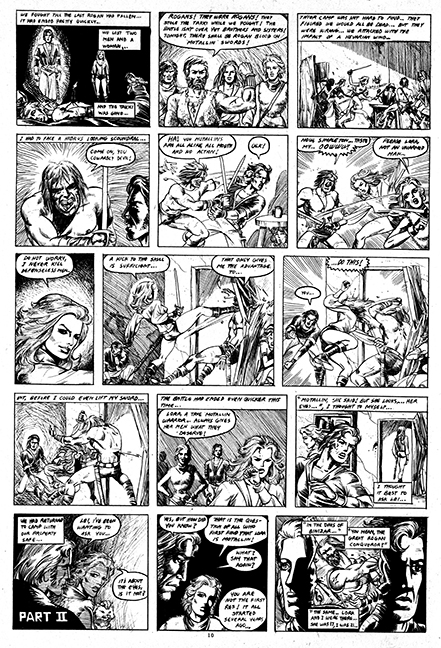


Following Hernandez is The Man in the Moon, with story by Mark Lamport, and art by Max Giguere and Jean Pierre Normand. I have a feeling Max handled the people and Jean the ships, as you will see a spaceship pin up by him later on. Below are a few pages to give you a taste (as well as a later story, all by Lamport).
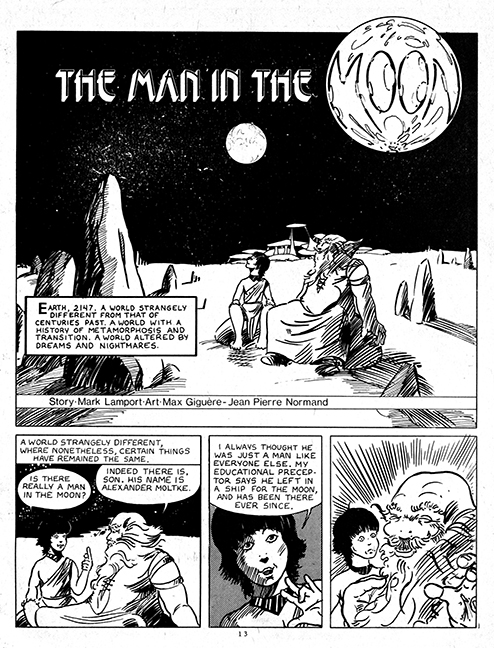
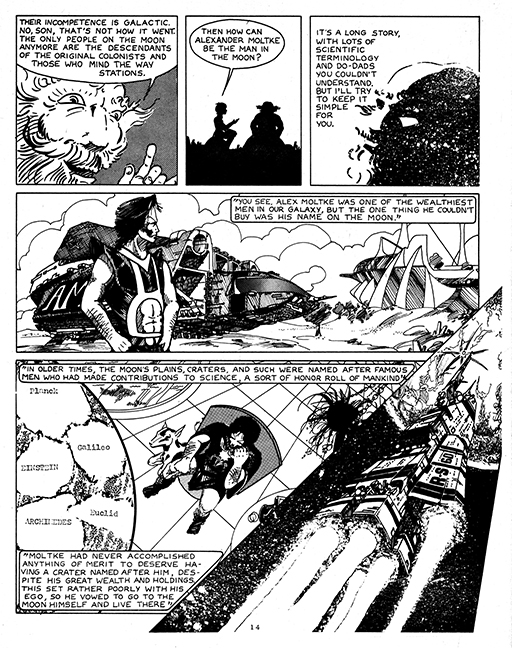
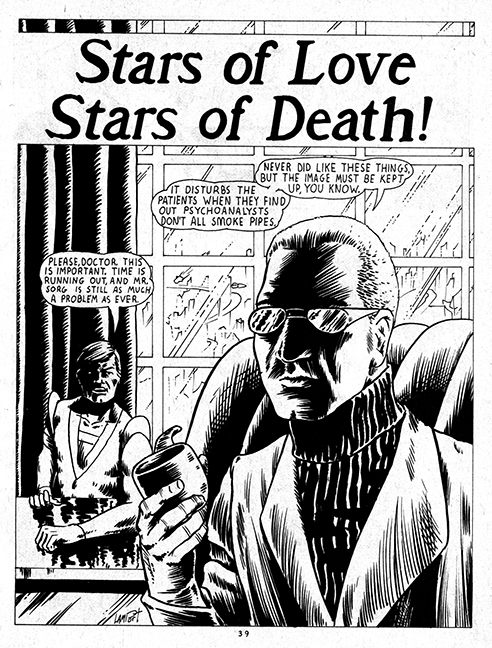
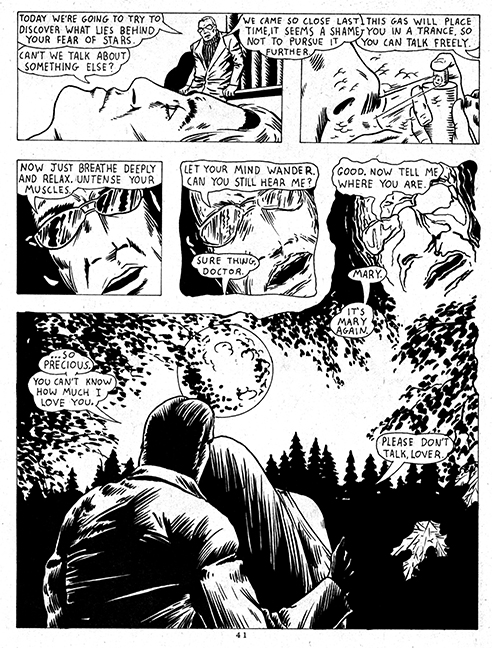

Following the first of those two stories is a one pager that is somewhat of out of sorts in this bunch, called Lance Lush, by Peter Ommundsen. It sorta reminds of the later Reid Fleming, World’s Dangerous Milkman.
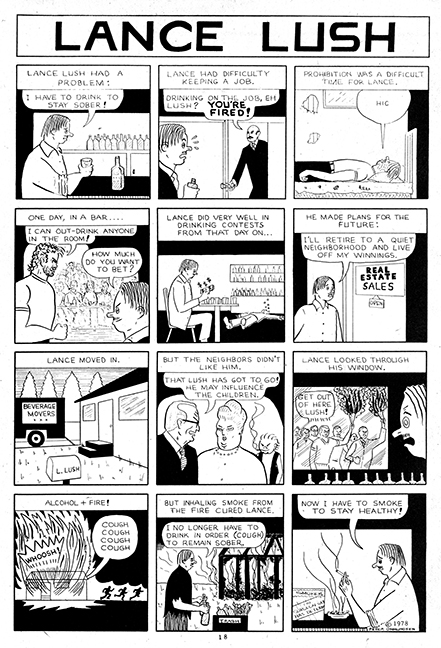
Before I show work from some of the other stories, below you see a pin up by one very young Rafael Kayanan. He told me on Facebook he did this in middle school! Rafael’s work appeared in other fanzines, such as No Sex, and he later went on to work for pretty much every major comics company, as well as video games and more. From his Wikipedia page, the most fascinating part is that he “is a Master-level edged weapons (knife, sword, tomahawk) expert and instructor in Sayoc Kali. This rare combination of a visual and martial artist has led to projects which utilize both skills to illustrate fight storyboards for film and TV. Kayanan choreographed and trained the actors in William Friedkin’s The Hunted, starring Benicio del Toro and Tommy Lee Jones. He also trained actor Sam Rockwell for director George Clooney’s film, Confessions of a Dangerous Mind. Kayanan was a development artist, fight trainer and weapons consultant for the adaptation of Edgar Rice Burroughs’ John Carter. ” Other films and tv work fill his resume as well. What a renaissance man! [Right as this column was “going to press,” Rafael let me know he is also now a tv producer! Check it out here]
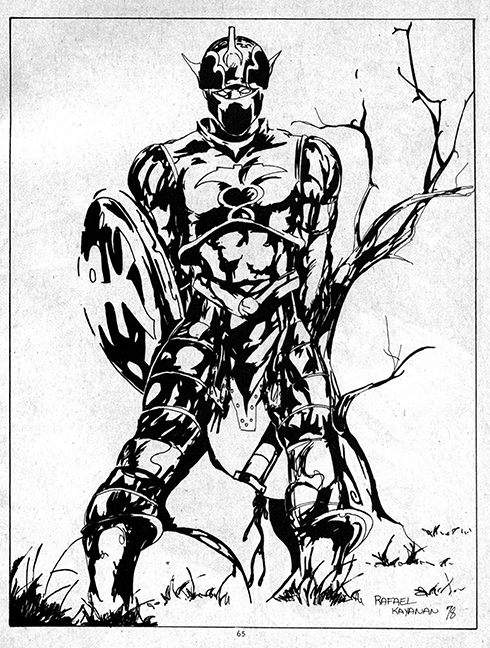
Rafael was kind enough to answer a few questions I posed to him.
Q: When did you start reading comics, when did you start drawing?
A: I started looking at comics before I could read. My dad would bring home stacks of books when we lived in the Philippines. He’d have Marvel era Lee/Kirby as well as Filipino comics that had the work of Nestor Redondo, Alfredo Alcala and more. My first recollection of drawing anything good was copying a Gene Colan Daredevil that had a double page spread with a character called Mr. Fear. I was attracted to the kinetic hyper realism of Colan’s figures and composition.
Q: When did you start reading fanzines…any favorites that you can remember?
A: I started when I subscribed to The Comics Buyers Guide and saw all these ads of fanzines. I thought how cool it was that a teenager like myself could get practice in production. I could also interact with like- minded amateurs who had far more experience in print. I picked up Afta by the late Bill-Dale Marcinko and really thought the content spoke to my sensibilities. It was covering so many subjects that I had limited exposure to. I was living in a very small SW Florida town during this period. Everything was done via the post office. Taking a week to get a quick reply! Haha! Lots of hand written letters with fellow artists and storytellers across the country. It sounds so primitive during the wi-fi age we live in now. Although I recall those times with great fondness, I just soaked in as much information as I could. My work got stronger and I learned by doing.
Q: Do you remember the first fanzine you were printed in (christ, maybe it was in elementary school!)
A: Ha! It was called Fanta-zine or something close to it. Another kid close to my age was just printing it on his own with his friends and other CBG contributors. Creators like Daniel Clowes were sending in strips.
Q: Did the work you did in fanzines prepare you at all for the pro work you did later?
A: It did, in that I was used to interacting and working with fellow artists and writers by then. Many of which eventually broke into the industry. I saw the limitations of print, and the responsibility of finishing things before deadline. I was used to inquiring and sending my work to editors.
Q: I am pretty sure you did some work for David Heath Jr in No Sex….any memory of that?
A: I had corresponded with David a few times. I really enjoyed the energy he had for his zine. He had such a unique style and point of view in his stories. He asked to ink an image I penciled but there was a big disparity in artistic quality in terms of David already being an adult serving in the military and I was literally like 15 years old. He just let me feel my art was fine and fit with his zine. Such a good dude and I was glad we emailed each other a few times before he passed. He was setting up his website and tracking down talents from the past. That drawing in Fandom Circus was done my last year in middle school. He was a character called “Photon” who was this energy being in humanoid form that was trapped in this armor. It’s just amusing to see how I made artistic choices while having no real clue of ink drawing. It was all enthusiasm and violence drawn with small nibbed rapidographs.
Three more stories follow, By the Way by Bud Perkins, Vampyre by Kirk Tineblad, and Skeetra and the Gang, by Ken Hahn. Then, we enter a space battle story reminiscent of those great Jim Starlin epics, Mindworm, by Garry Hardman (who also did the back cover you see at top). Hardman did work in several zines back then, and I caught up with him on Facebook for a few comments. Like many artists at that time, long before the internet, Garry was operating in a vacuum of sorts, no fellow comic fans or artists around him. The story below, he says, was done at age 22, and shows his love of zip-a-tone.
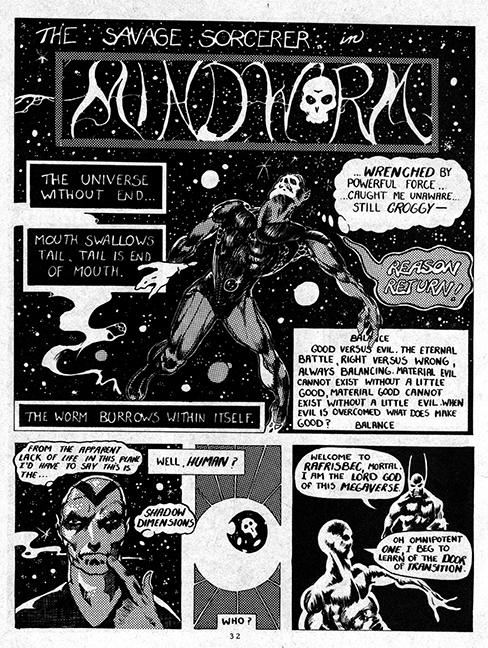
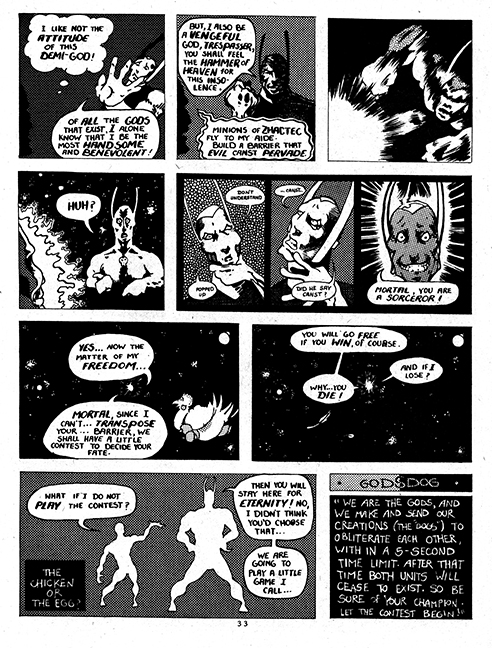
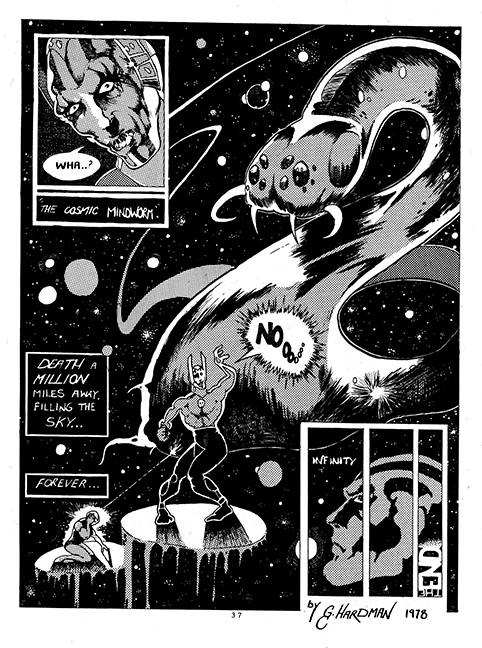
When I asked about his formative years, he said:
I was about 15 years old when I started being interested in doing comics. That year I bought a sketchbook and a rapidograph pen. I didn’t do any pencilling, just drawing characters [in ink]. I really wasn’t aware that you had to pencil first! When I was drawing I had to be aware of form and composition. I had heard that Bernie Wrightson visualized the image before drawing it…so I attempted to do it that way. Later, when I pencilled things out, it was much easier. Same with the leroy letterer [system, a way to trace letters through plastic guides]. No more lettering on imaginary lines. I got pretty good at drawing other people’s style through analysis.
I asked him to think about his influences, and he elaborated:
I was a big Jim Starlin fan. And as far as storytelling, Jim Steranko, Berni Wrightson and some other graphics people. I was trying to learn brush work and was using a bamboo brush that was primitive as heck. No nylon bristles or squirrel hair. I would have been better off with a chewed up tooth pick! I was also a Frank Frazetta fan, as far as his paintings. I had a long list of artists that inspired and influenced me back then. As far as comic strips went it was George Wunder, Roy Crane, Hal Foster, Alex Raymond and a host of others. Wally Wood, Steranko, Barry Smith, Richard Corben, and many of the other comic book stylists. Currently, many of the european cartoonists, such as those that did Judge Dredd and appeared in Heavy Metal affect me. Also at this time I am involved with several international underground comic books, doing work for them.
I wondered if he had tried to approach some of the mainsteam companies at any point and he said “I tried but it didnt pan out. I did get some great feedback from Marie Severin, Bill Pearson and Wally Wood. I did get accepted at National Lampoon by Shary Flenniken, but I chickened out. I was going to college and working full time.” He also told me he has done hundreds of pages for Clay Geerdes underground comics company, as well as many paintings for covers of local newspapers and magazines. Unfortunately, he has been hit by a double whammy…his house burned down in 1991, along with all of his art. On top of that, he had a stroke a while back, so his memory of some of this work from way back escapes him nowadays.
The last story in this zine is by Jack Bertram and is called The Anarchist. Jack has a loose style that reminds me a bit of some of the high contrast work of Frank Miller, as well as the Vertigo-esque work of people like Michael Gaydos. There are lots of thick patches next to thin lines…this works best in the first few pages, as seen below. It’s funny, I have been Facebook friends with Bertram for awhile now, but only recently made the connection that was the same person! When I asked what his situation was when he did this particular story, he said
I had graduated from UC Irvine in 1977 with a BA in Art. A few months later I opened a comic book store with my mother. The store was only open a year before it went down, do to lack of business. I was drawing this comic while I was running the store. I had my drawing table set up in the store and I would draw during business hours, when I had the time. So, I was 22 at the time and had great dreams of being a comic book artist.

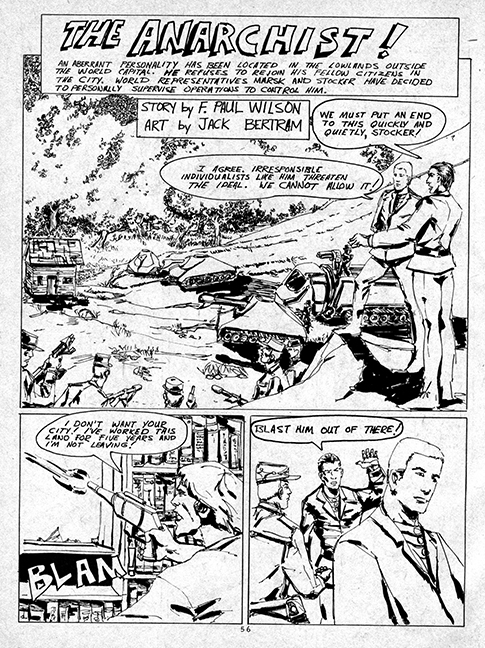
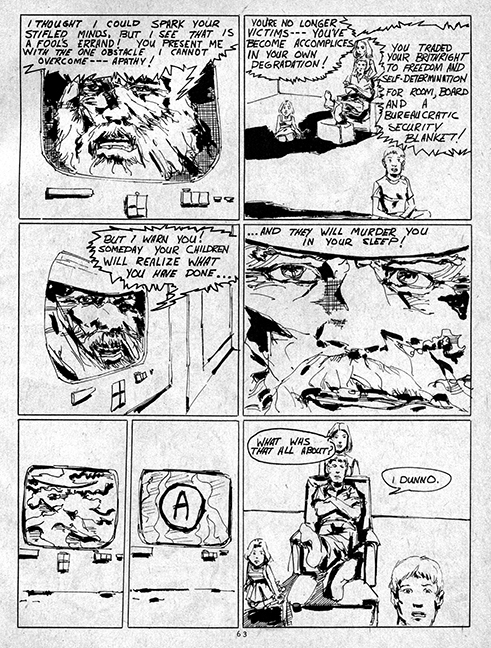
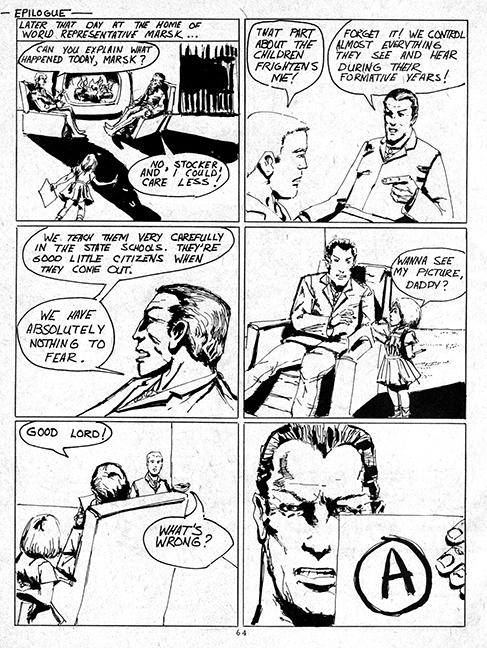
On the subject of influences, Jack says that “Jack Kirby has always been an inspiration to me. Other artists like Gil Kane, Gene Colan, Wally Wood, Neal Adams, Gray Morrow and so many more were factors. It’s hard to say who was influencing me at that time. I think there’s some Neal Adams there and some Gray Morrow, in spirit, if not in technique.” Like most of us, Jack had been reading comics by this time, saying “I had been reading comics since the Batman TV series. I started read the black and white Batman reprints that were published as paperbacks. Then a neighbor kid introduced me to regular comics. He knew about Ditko, Kirby and all that. I started buying everything I could get my hands on. Comics were still 12 cents then, so that was a lot.”
Bertram tried to submit to other fanzines, but “with no luck. These other fanzines needed to see more than just single drawings, they needed to see finished comics. I don’t blame them. I was unable to put anything together. In ’78 I also did 2 covers for a zine called Future Gold. Then in 1983 I did some cartoons for CBG.” Some of Jack’s favorite zines included RBCC, Anomaly, and Fantasmagoria. And, also like many of us, Jack existed in somewhat of a comic vacuum.
I was somewhat isolated from fandom, at that time. My connection to fandom was the RBCC and CBG in its earlier incarnation. I felt connected through those publications, but I didn’t have any personal connections. Oh, but I did go to Comic Con through most of the 70’s. I enjoyed that, but still didn’t make any personal connections. I was pretty shy back then. I’m still shy, but a little less than I used to be.
Jack has done a lot since then, saying
After my comic book store went down I got a graphic arts job. It was for a company that did display ads for the Yellow Pages. It was on the low end of the graphic arts world. Some of it was fun, when I got to do drawings for the ads. I continued to try to get fanzine work, mailed in a few samples to Marvel, DC and Charlton. In 1988 I started getting involved in the small press and that’s where most of my work has been appearing.
You may be able to see the influence in the inside covers (which actually form one image) by Paul Shaffer (no, not Letterman’s Paul), seen below…

Lastly, as I mentioned in reference to an earlier story, below is a space ship pin up by Jean Pierre Normand.
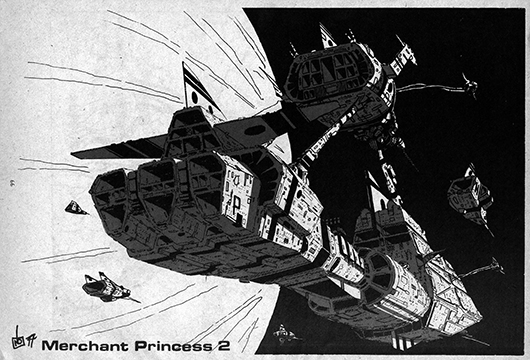
This is one that you definitely to see the whole pdf to get the most out of the fanzine. Go to my site here and scroll down to the bottom, and click on Fandom Circus.
Thanks for helping with this installment go out to Garry Hardman, Jack Bertram, and Rafael Kayanan.
As always, please leave comments so I don’t feel so all alone, leave requests for zines you would like to cover or send me your copies and become a part yourself!
Ken Meyer Jr.
kenmeyerjr@yahoo.com


Ken, thanks for interviewing me for this article. After the publication of Fandom Circus #2, over the years, I was amazed to see some of the names of the contributors pop up in professional publications. B.C. Boyer went on to do The Masked Man for Eclipse Comics. Marc Lamport did some work on a comic called the Southern Knights which, at one point, was published by David Anthony Kraft’s Comics Interview. I felt like I had seen Peter Ommundsen’s name since Fandom Circus, so I looked him up. I found he has a site for his cartoons; http://www.capewest.ca/cartoons.html#BIO
I enjoyed this article and the whole series that you are doing on these fanzines. I haven’t read all your entries, yet, but I will get to it.
Thanks, Jack! I totally forgot about Boyer and Eclipse…and I vaguely remember that Southern Knights as a title. Glad you liked it and hope you have fun with the other installments!
Exciting stuff – thanks a lot !
I just watched an interview with Jaime Hernandez and he said this was his first published work. What happened to the images? Please re-upload the imagines for historically reference.
Thanks so much for making all this available, along with info-packed text! I am a little insecure though, I jumped to the pdf of No Sex #14 and couldn’t find Jaime material, only Beto. I also see Jaime listed on https://fancyclopedia.org/No_Sex in #14 and 18. Please set me straight on this and help me with these small reference facts.